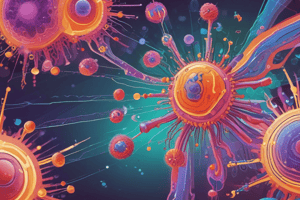Podcast
Questions and Answers
Which of the following best describes the role of cell-to-cell communication during a response to an invasion of antigens?
Which of the following best describes the role of cell-to-cell communication during a response to an invasion of antigens?
- Chemicals secreted from antigen-presenting cells activate helper T cells. (correct)
- Helper T cells initiate the production of antibodies.
- Antigens directly kill invading pathogens.
- Antibodies neutralize antigens without communication.
Which of the following statements best describes a primary function of plasmodesmata?
Which of the following statements best describes a primary function of plasmodesmata?
- They enable photosynthesis.
- They allow the movement of molecules from one cell to another. (correct)
- They seal plant cells to prevent water loss.
- They store nutrients for the plant.
Which of the following best explains a possible mechanism that would enable a hormone to efficiently reach all of the target cells in the body?
Which of the following best explains a possible mechanism that would enable a hormone to efficiently reach all of the target cells in the body?
- The hormone diffuses through the cell membranes.
- The hormone is released into the bloodstream. (correct)
- The hormone binds to a specific enzyme for transport.
- The hormone is delivered directly to each cell by receptors.
Which of the following describes a critical role of cAMP during the transduction stage of a G protein signal transduction pathway?
Which of the following describes a critical role of cAMP during the transduction stage of a G protein signal transduction pathway?
Which of the following best describes the component that metformin represents in a signal transduction pathway that regulates glucose production in the liver?
Which of the following best describes the component that metformin represents in a signal transduction pathway that regulates glucose production in the liver?
What typically occurs first once a chemical messenger reaches a target cell?
What typically occurs first once a chemical messenger reaches a target cell?
Which of the following justifies the claim that differences in components of cell signaling pathways explain the different responses to epinephrine?
Which of the following justifies the claim that differences in components of cell signaling pathways explain the different responses to epinephrine?
Which statement provides the evidence to justify the claim that signal transduction may result in an altered phenotype?
Which statement provides the evidence to justify the claim that signal transduction may result in an altered phenotype?
Which of the following statements best justifies the claim that changes in the expression of ced-9 in C. elegans can affect regulation of apoptosis in the cell?
Which of the following statements best justifies the claim that changes in the expression of ced-9 in C. elegans can affect regulation of apoptosis in the cell?
Flashcards are hidden until you start studying
Study Notes
Immune Response and Antigens
- Antigens trigger immune responses in host organisms, recognized by specific antibodies produced by the immune system.
- Cell-to-cell communication is vital in this process, where chemicals secreted by antigen-presenting cells activate helper T cells.
Plasmodesmata in Plant Cells
- Plasmodesmata are narrow channels connecting adjacent plant cells through cell walls, allowing cytoplasmic communication.
- Their primary function is to facilitate the movement of molecules between cells, enhancing intercellular communication.
Hormonal Signaling
- Hydrophilic peptide hormones from the anterior pituitary gland target specific body cells.
- These hormones are released into the bloodstream, enabling transportation to all cells possessing the appropriate receptors.
G Protein Signal Transduction
- G proteins transmit extracellular signals to the interior of a cell upon activation by signaling molecules.
- cAMP acts as a second messenger, activating enzymes that amplify the signal, significantly influencing the transduction process.
Metformin and Glucose Regulation
- Metformin, used for treating type 2 diabetes, lowers glucose production in the liver by activating AMPK.
- AMPK activation is essential for metformin’s inhibitory effects, as it cannot cross the plasma membrane independently, indicating it acts as a ligand in this signal transduction pathway.
Initial Steps in Signaling Pathways
- The critical first step in a signaling pathway after a chemical messenger reaches a target cell is ligand binding to a receptor.
Epinephrine Response Variation
- During fight-or-flight responses, epinephrine distributed via the circulatory system may elicit varied cellular responses based on receptor presence.
- Only cells with epinephrine receptors can respond to the hormone, highlighting the importance of receptor availability in signaling pathways.
Signal Transduction and Phenotypic Changes
- Changes in gene expression due to signal transduction can alter cellular functions and phenotypes, such as the SRY gene’s role in male sexual development.
- Absence or dysfunction of the SRY gene leads to female sexual development, evidencing the impact of signaling pathways on phenotype.
Apoptosis in C. elegans
- Researchers studied apoptosis in C. elegans to understand programmed cell death, identifying key regulating genes like ced-9 and ced-3.
- A mutation in ced-9 results in excessive cell death, illustrating how changes in gene expression can affect apoptosis regulation.
Insulin Receptor Functionality
- The insulin receptor, a transmembrane protein, regulates glucose homeostasis in the body by binding specific peptide hormones.
Studying That Suits You
Use AI to generate personalized quizzes and flashcards to suit your learning preferences.




